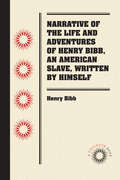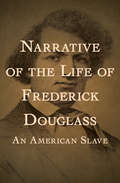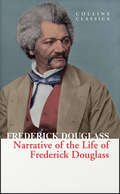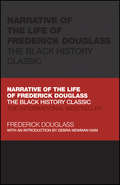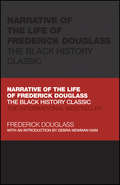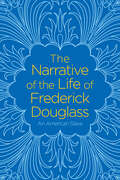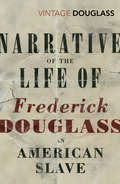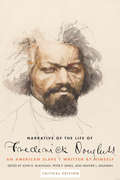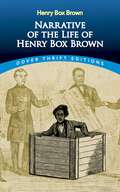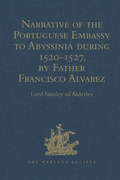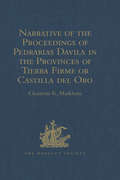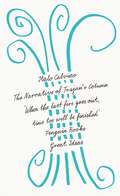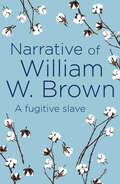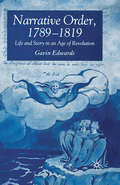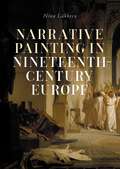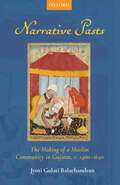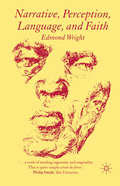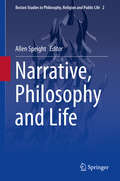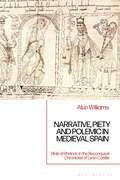- Table View
- List View
Narrative of the Life and Adventures of Henry Bibb, An American Slave, Written by Himself
by Henry BibbHenry Bibb (1815-1854) was born to an enslaved woman named Mildred Jackson in Shelby County, Kentucky. His father was a state senator who never acknowledged him. His narrative documents his persistent attempts to escape to freedom, beginning at age ten, offering an insider's view of the degradation and varieties of slavery as well as its bitter legacies within families. Having finally settled in Detroit in 1842, Bibb joined the abolitionist lecture circuit and lived the rest of his days as a well-known African American activist who believed that Canada might offer a haven for the formerly enslaved.Bibb's autobiography, Narrative of the Life and Adventures of Henry Bibb, An American Slave, was published in 1849. Scholars have pointed out that Bibb's narrative has several distinguishing features among the larger body of slave narratives. Unusually, Bibb survived enslavement in the Deep South and later described it, and his narrative offers documentation of African folkways including conjuring and an account of Native American slaveholding practices as well. Henry Bibb was above all resilient and determined to achieve freedom for himself and others. Unwilling to abandon those he loved, he risked recapture several times to free them from enslavement, too. In the small span of his thirty-nine years he would live to be reunited with three of his brothers who had fled to Canada.A DOCSOUTH BOOK. This collaboration between UNC Press and the University of North Carolina at Chapel Hill Library brings classic works from the digital library of Documenting the American South back into print. DocSouth Books uses the latest digital technologies to make these works available in paperback and e-book formats. Each book contains a short summary and is otherwise unaltered from the original publication. DocSouth Books provide affordable and easily accessible editions to a new generation of scholars, students, and general readers.
Narrative of the Life and Adventures of Henry Bibb, An American Slave, Written by Himself
by Henry BibbHenry Bibb (1815-1854) was born to an enslaved woman named Mildred Jackson in Shelby County, Kentucky. His father was a state senator who never acknowledged him. His narrative documents his persistent attempts to escape to freedom, beginning at age ten, offering an insider's view of the degradation and varieties of slavery as well as its bitter legacies within families. Having finally settled in Detroit in 1842, Bibb joined the abolitionist lecture circuit and lived the rest of his days as a well-known African American activist who believed that Canada might offer a haven for the formerly enslaved.Bibb's autobiography, Narrative of the Life and Adventures of Henry Bibb, An American Slave, was published in 1849. Scholars have pointed out that Bibb's narrative has several distinguishing features among the larger body of slave narratives. Unusually, Bibb survived enslavement in the Deep South and later described it, and his narrative offers documentation of African folkways including conjuring and an account of Native American slaveholding practices as well. Henry Bibb was above all resilient and determined to achieve freedom for himself and others. Unwilling to abandon those he loved, he risked recapture several times to free them from enslavement, too. In the small span of his thirty-nine years he would live to be reunited with three of his brothers who had fled to Canada.A DOCSOUTH BOOK. This collaboration between UNC Press and the University of North Carolina at Chapel Hill Library brings classic works from the digital library of Documenting the American South back into print. DocSouth Books uses the latest digital technologies to make these works available in paperback and e-book formats. Each book contains a short summary and is otherwise unaltered from the original publication. DocSouth Books provide affordable and easily accessible editions to a new generation of scholars, students, and general readers.
Narrative of the Life of Frederick Douglass
by Frederick DouglassA dramatic autobiography and powerful firsthand account of slavery, written by America’s most influential abolitionist First published in 1845, Narrativeof the Life of Frederick Douglass is an eye-opening depiction of American slavery. Part autobiography, part human-rights treatise, it describes the everyday horrors inflicted on captive laborers, as well as the strength and courage needed to survive. Born into slavery on a Maryland plantation in 1818, Frederick Douglass spent years secretly teaching himself to read and write—a crime for which he risked life and limb. After two failed escapes, Douglass finally, blessedly boarded a train in 1838 that would eventually lead him to New York City, and freedom. Few books have done more to change America’s notion of African Americans than this seminal work. Beyond its historical and social relevancy, it is admired today for its gripping stories, intensity of spirit, and heartfelt humanity. This ebook has been professionally proofread to ensure accuracy and readability on all devices.
Narrative of the Life of Frederick Douglass: Classic Novel Posters (Collins Classics)
by Frederick DouglassHarperCollins is proud to present its incredible range of best-loved, essential classics.
Narrative of the Life of Frederick Douglass: An American Slave, Written by Himself (The John Harvard Library #105)
by Frederick DouglassNo book more vividly explains the horror of American slavery and the emotional impetus behind the antislavery movement than Frederick Douglass’s Narrative. In an introductory essay, Robert B. Stepto reexamines the extraordinary life and achievement of a man who escaped from slavery to become a leading abolitionist and one of our most important writers. The John Harvard Library text reproduces the first edition, published in Boston in 1845.
Narrative of the Life of Frederick Douglass: The Black History Classic (Capstone Classics)
by Frederick DouglassDISCOVER ONE OF THE MOST IMPORTANT ACCOUNTS OF SLAVERY IN NINETEENTH CENTURY AMERICA One of history’s greatest crimes, the American slave trade led to the suffering of untold numbers of men and women. But how can we better understand the lives and experiences of those who endured it?Narrative of the Life of Frederick Douglass is a harrowing first hand look at the brutal indignities of slavery in the nineteenth century, and the society that allowed it to happen. To better understand our shared present, we need to fully grapple with our difficult past. Douglass’ Narrative is a key piece of that puzzle.An insightful introduction by Debra Newman Ham, a former Black history archivist for the Library of Congress, analyzes the text and looks at the key events in Douglass’ life.
Narrative of the Life of Frederick Douglass: The Black History Classic (Capstone Classics)
by Frederick DouglassDISCOVER ONE OF THE MOST IMPORTANT ACCOUNTS OF SLAVERY IN NINETEENTH CENTURY AMERICA One of history’s greatest crimes, the American slave trade led to the suffering of untold numbers of men and women. But how can we better understand the lives and experiences of those who endured it?Narrative of the Life of Frederick Douglass is a harrowing first hand look at the brutal indignities of slavery in the nineteenth century, and the society that allowed it to happen. To better understand our shared present, we need to fully grapple with our difficult past. Douglass’ Narrative is a key piece of that puzzle.An insightful introduction by Debra Newman Ham, a former Black history archivist for the Library of Congress, analyzes the text and looks at the key events in Douglass’ life.
The Narrative of the Life of Frederick Douglass (Arcturus Classics)
by Frederick DouglassA classic story of agonizing circumstances and enduring hope, The Narrative of the Life of Frederick Douglass is an eloquent account of a young man's life under slavery and his eventual escape. Written to promote the abolitionist cause, it became the best-selling fugitive slave narrative of the era. This autobiography is a powerful reminder of the brutality of slavery and the terrors that African-American people were forced to endure.
The Narrative of the Life of Frederick Douglass
by Frederick DouglassThis fiery autobiography, written as anti-slavery propaganda, tells of Douglass' struggle to gain freedom and became a 19th century national bestseller. [This text is listed as an example that meets Common Core Standards in English language arts in grades 6-8 at http://www.corestandards.org.]
Narrative of the Life of Frederick Douglass, an American Slave: Written By Himself (Oxford World's Classics)
by Frederick Douglass‘A masterpiece … [Douglass] was not only self-educated, with a love of language which should still be an inspiration; he was also self-created’ New York Times Frederick Douglass was born into slavery in Maryland in 1818. After his escape in 1838 he became an ardent abolitionist, and his autobiography was an instant bestseller upon publication in 1845. In it he describes with harrowing honesty his life as a slave – the cruelty he suffered at the hands of plantation owners; his struggles to educate himself in a world where slaves are deliberately kept ignorant; and ultimately, his fight for his right to freedom. A passionately written, intelligent and highly emotive indictment of slavery, his principle preoccupation was that slavery could be eradicated only through education. This text was key in helping to secure its eventual abolition.
Narrative of the Life of Frederick Douglass, an American Slave: Written by Himself, Critical Edition
by Frederick DouglassA new edition of one of the most influential literary documents in American and African American history Ideal for coursework in American and African American history, this revised edition of Frederick Douglass’s memoir of his life as a slave in pre-Civil War Maryland incorporates a wide range of supplemental materials to enhance students’ understanding of slavery, abolitionism, and the role of race in American society. Offering readers a new appreciation of Douglass’s world, it includes documents relating to the slave narrative genre and to the later career of an essential figure in the nineteenth-century abolition movement.
Narrative of the Life of Henry Box Brown: Written By Himself (Dover Thrift Editions)
by Henry Box BrownAfter enduring more than 30 years of slavery, Henry "Box" Brown achieved freedom by having himself nailed inside a packing crate and shipped from Richmond to Philadelphia. Initially published in 1851, Brown's extraordinary memoir recounts the harsh circumstances of his bondage as well as the details of his 350-mile journey by railroad, steamboat, and horse cart inside a container three feet long and two feet wide.Acclaimed by Dr. Cornel West as "one of the great creative acts in the struggle for black freedom," the story of Brown's daring escape continues to resonate as a reflection of the ongoing struggles of oppressed people around the world. Professor Henry Louis Gates, Jr., declared this narrative "just as relevant now as it was 150 years ago," and modern readers will find it an unforgettable source of inspiration.
Narrative of the Portuguese Embassy to Abyssinia during the Years 1520-1527, by Father Francisco Alvarez (Hakluyt Society, First Series)
by Lord Stanley AlderleyTranslated from the Portuguese, and edited, with notes and an introduction. For a revised edition, see Second Series 114, 115. This is a new print-on-demand hardback edition of the volume first published in 1881.
Narrative of the Portuguese Embassy to Abyssinia during the Years 1520-1527, by Father Francisco Alvarez (Hakluyt Society, First Series)
by Lord Stanley AlderleyTranslated from the Portuguese, and edited, with notes and an introduction. For a revised edition, see Second Series 114, 115. This is a new print-on-demand hardback edition of the volume first published in 1881.
Narrative of the Proceedings of Pedrarias Davila in the Provinces of Tierra Firme or Castilla del Oro: And of the Discovery of the South Sea and the Coasts of Peru and Nicaragua. Written by the Adelantado Pascual de Andagoya (Hakluyt Society, First Series)
by Clements R. MarkhamTranslated and Edited, with Notes and an Introduction, from the Text written c. 1514. The supplementary material includes the 1865 annual report. This is a new print-on-demand hardback edition of the volume first published in 1865.
Narrative of the Proceedings of Pedrarias Davila in the Provinces of Tierra Firme or Castilla del Oro: And of the Discovery of the South Sea and the Coasts of Peru and Nicaragua. Written by the Adelantado Pascual de Andagoya (Hakluyt Society, First Series)
by Clements R. MarkhamTranslated and Edited, with Notes and an Introduction, from the Text written c. 1514. The supplementary material includes the 1865 annual report. This is a new print-on-demand hardback edition of the volume first published in 1865.
The Narrative of Trajan's Column (Penguin Great Ideas)
by Italo Calvino'When the last fire goes out, time too will be finished'Italo Calvino was one of the most joyful and imaginative writers of the twentieth century. Here he muses on what the things we leave behind - whether waxworks or ancient graffiti, enigmatic maps or a crumbling Roman column - tell us about the greater truths of the world, space and time.One of twenty new books in the bestselling Penguin Great Ideas series. This new selection showcases a diverse list of thinkers who have helped shape our world today, from anarchists to stoics, feminists to prophets, satirists to Zen Buddhists.
Narrative of William W. Brown: A Fugitive Slave (Arcturus Classics)
by William W. Brown"Even a name by which to be known among men, slavery had denied me." A standout among slave testimonies, the Narrative of William W. Brown provides a revealing account of life as a slave in mid-19th century Missouri. Written with harrowing clarity and heart-breaking honesty, it is a striking account of the struggle to survive under slavery and the terrifying risks run by slaves trying to escape its grasp in antebellum America.
Narrative Order, 1789-1819: Life and Story in an Age of Revolution
by G. EdwardsIn the decades immediately following the French Revolution, British writers saw the narrative ordering of experience as either superficial, dangerous or impossible. Linking storytelling to other forms of social action, including the making of contracts and promises, Gavin Edwards argues that the experience of radical social upheaval produced a widespread scepticism about narrative as linguistic artefact, the transmission of narrative through storytelling and the understanding of individual or collective life as a temporal sequence with a beginning and an end.
Narrative painting in nineteenth-century Europe
by Nina LübbrenThis ground-breaking book presents a critical study of pictorial narrative in nineteenth-century European painting. Covering works from France, Germany, Britain, Italy and elsewhere, it traces the ways in which immensely popular artists like Jean-Léon Gérôme, Karl von Piloty and William Quiller Orchardson used unique visual strategies to tell thrilling and engaging stories. Regardless of genre, content or national context, these paintings share a fundamental modern narrative mode. Unlike traditional art, they do not rely on textual sources; nor do they tell stories through the human body alone. Instead, they experiment with objects, spaces, cause-and-effect relations and open-ended ambiguity, prompting viewers and reviewers to read for clues in order to weave their own elaborate tales.
Narrative painting in nineteenth-century Europe
by Nina LübbrenThis ground-breaking book presents a critical study of pictorial narrative in nineteenth-century European painting. Covering works from France, Germany, Britain, Italy and elsewhere, it traces the ways in which immensely popular artists like Jean-Léon Gérôme, Karl von Piloty and William Quiller Orchardson used unique visual strategies to tell thrilling and engaging stories. Regardless of genre, content or national context, these paintings share a fundamental modern narrative mode. Unlike traditional art, they do not rely on textual sources; nor do they tell stories through the human body alone. Instead, they experiment with objects, spaces, cause-and-effect relations and open-ended ambiguity, prompting viewers and reviewers to read for clues in order to weave their own elaborate tales.
Narrative Pasts: The Making of a Muslim Community in Gujarat, c. 1400–1650
by Jyoti Gulati BalachandranThis book explores the narrative power of texts in creating communities. Through an investigation of genealogical, historical, and biographical texts, it retrieves the social history of the Muslim community in Gujarat, a region with one of the earliest records of Muslim presence in the Indian subcontinent. By reconstructing the literary, social, and historical world of Sufi preceptors, disciples, and descendants from the fifteenth to the seventeenth century, Jyoti Gulati Balachandran highlights the role of learned Muslim men in imparting a prominent regional and historical identity to Gujarat. The book reveals how distinct forms of community and association were created and shaped over time through architecture, shrine veneration, and most importantly, textual redefinition. Narrative Pasts demonstrates that Gujarat was not only an important hub of maritime Indian Ocean trade, but also an integral part of the historical and narrative processes that shaped medieval and early modern South Asia. Employing new and rarely used literary materials in Persian and Arabic, this book brings new life and vitality to the history of the region by integrating Gujarat’s sultanate and Mughal past with the larger socio-cultural histories of Islamic South Asia.
Narrative, Perception, Language, and Faith
by E. WrightThere have been many voices in disciplines as various as philosophy, history, psychology, hermeneutics, literary theory, and theology that have claimed that narrative is fundamental to all that is human. Here is a book that, in an engaging and amusing way, presents a coherent thesis to that effect, connecting the Joke and the Story (with all that comedy and tragedy imply) not only with our sensing and perceiving of the world, but with our faith in each other, and what the character of that faith should be.
Narrative, Philosophy and Life (Boston Studies in Philosophy, Religion and Public Life #2)
by Allen SpeightThis notable collection provides an interdisciplinary platform for prominent thinkers who have all made significant recent contributions to exploring the nexus of philosophy and narrative. It includes the latest assessments of several key positions in the current philosophical debate. These perspectives underpin a range of thematic strands exploring the influence of narrative on notions of selfhood, identity, temporal experience, and the emotions, among others. Drawing from the humanities, literature, history and religious studies, as well as philosophy, the volume opens with papers on narrative intelligence and the relationship between narrative and agency. It features special sections of in-depth commentary on a range of topics. How, for example, do narrative and philosophical biography interact? Do celebrated biographical and autobiographical accounts of the lives of philosophers contribute to our understanding of their work? This new volume has a substantive remit that incorporates the intercultural religious view of philosophy’s links to narrative together with its many secular aspects. A valuable new resource for more advanced scholars in all its constituent disciplines, it represents a significant addition to the literature of this richly productive area of research.
Narrative, Piety and Polemic in Medieval Spain: Biblical Rhetoric in the Reconquest Chronicles of León-Castile
by Alun WilliamsThis book presents an original perspective on the variety and intensity of biblical narrative and rhetoric in the evolution of history writing in León-Castile during the twelfth and thirteenth centuries. It focuses on six Hispano-Latin chronicles, two of which make unusually overt and emphatic use of biblical texts. Of particular importance is the part played by the influence of exegesis that became integral to scriptural and liturgical influence, both in and beyond monastic institutions.Alun Williams provides close analysis of the text and comparisons with biblical typology to demonstrate how these historians from the north of Iberia were variously dependent on a growing corpus of patristic and early medieval interpretation to understand and define their world and their sense of place.Narrative, Piety and Polemic in Medieval Spain sees Williams examine this material as part of a comparative exploration of language and religious allusion, showing how the authors used these biblical-liturgical elements to convey historical context, purpose and interpretation.
